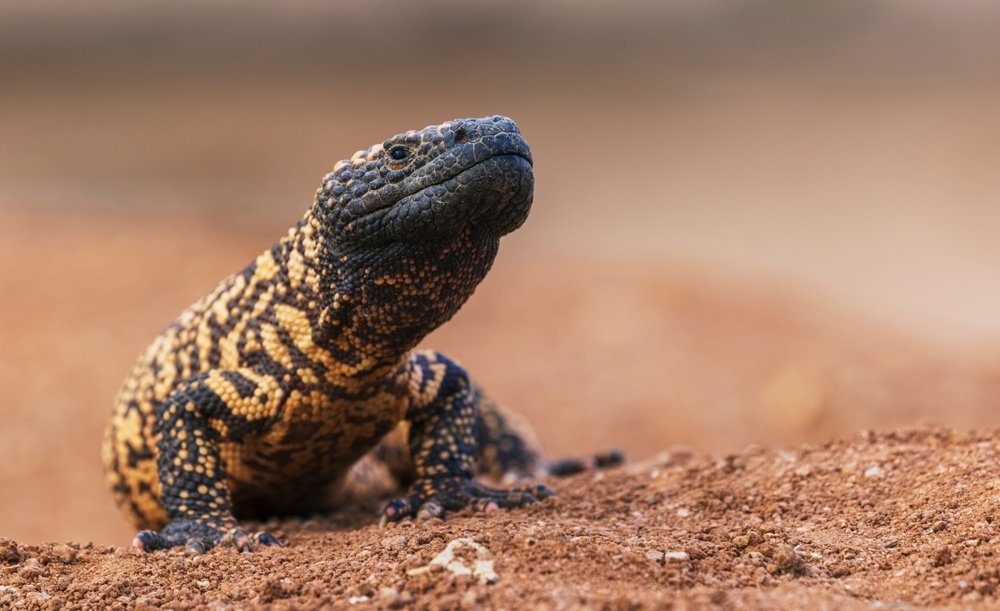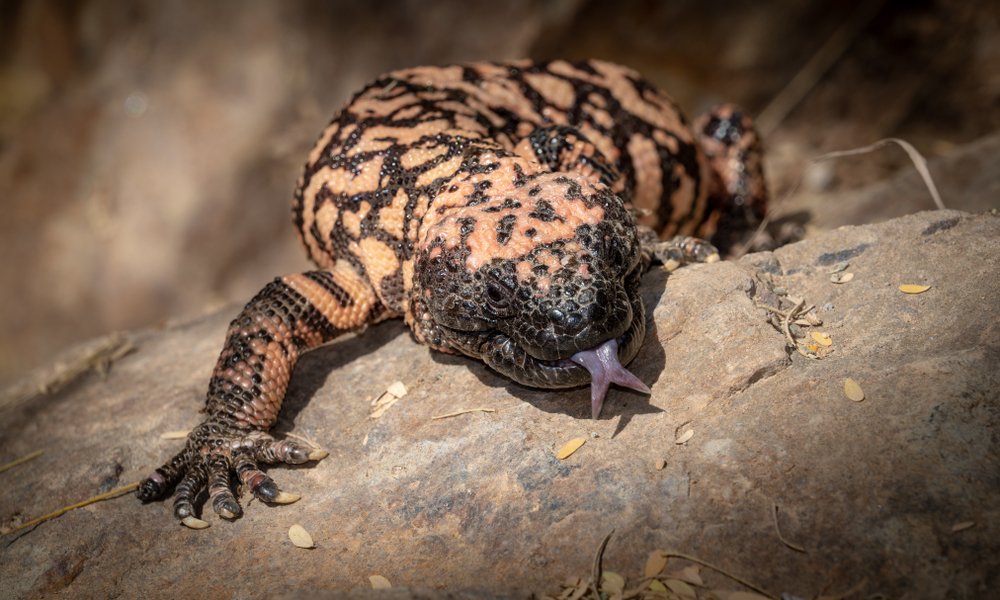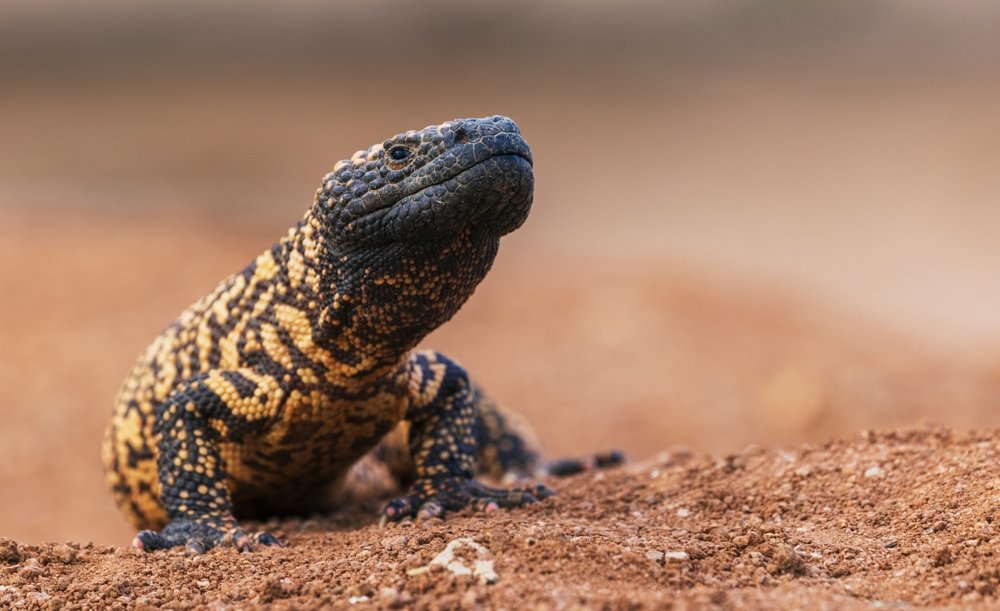The Gila Monster (Heloderma suspectum) is one of the most well-known lizards on the planet. Aside from the very catchy name, they’re commonly described as one of only two venomous lizards. We now know that primitive venom glands are present in several species, but regardless, the Heloderma genus certainly has the most advanced delivery methods. Despite a fearsome reputation, these lizards have seen significant threats to their native habitat and population numbers have been declining for over 15 years.

Heloderma
Although it’s easier to describe to budding herpetologists that the two venomous lizards are the beaded lizard and the gila monster, there are in fact five species belonging to the Heloderma genus. One ‘Gila monster’ and four species of beaded lizard. Populations of all species are currently in decline, with the Guatemala beaded lizard (H. charlesborgoti) now considered an endangered species comprised of fewer than 500 individuals left in the wild.
Despite being a widespread genus, stretching as far north as Utah and as far south as Guatemala, one significant threat links all populations from across each species: agricultural development and road infrastructure. These bulky lizards are predominantly slow-moving terrestrial animals and although some species of beaded lizard are often seen in trees above the ground, their arid habitats make road-crossings a common occurrence and one which rarely fares well for the animal. Couple this with a rather fearsome reputation and it is easy to see why the growing number of human-animal conflicts could spell disaster for these prehistoric reptiles.

Gila conservation
Although classified as a ‘near threatened’ species by the IUCN, there is significant cause to believe the Gila monster is facing many threats to localised populations. Outside of the safe havens provided by National Parks throughout the Southwest United States, Gila Monster numbers are continuing to decline.
This species was once abundant across its entire range and in 1952 was the first ever venomous animal to receive legal protection. This was a huge milestone in conservation efforts and helped reinforce positive attitudes towards these lizards, especially within a society that would regularly slaughter rattlesnakes for the potential harm they could cause to people or livestock. Ongoing protection plans have been reinforced with several states keeping a close eye on the species’ numbers. However, being a cryptic species that spends most the year below the ground, there is still much to learn before conservationists can actively implement measures that protect the longevity of the species. With many small towns located alongside rivers and fertile grounds which the Gila monster relies on, the growing infrastructure of these areas have seriously fragmented populations. Whilst their legal protection did offer some level of safeguarding, conservation efforts have not been straightforward.

Myths and monsters
Gila monsters have been shrouded in myths and superstition for thousands of years. Native American tribes had differing opinions of the species. Some feared the Gila monster and believed their breath to be deadly, while others believed the animal’s hide had healing properties. Although vastly different belief sets, neither provided a positive outcome for the lizards.
These myths were accelerated as settlers colonised the Southwest USA and the human population grew exponentially. Soon, it was widely believed that the Gila monster could kill a person with its breath and spit venom at its victim. Eventually this progressed to more outlandish rumours that the animal would defecate through its mouth, harbouring bacteria instead of venom. Even though these ideas seem absurd, the venom of the Glia monster does have a distinct smell which supported the continuation of these myths.
Throughout the 1900s, the population of America’s Southwest continued to grow and with more people living there, human-animal conflict became more common. Zoological studies dispelled many rumours but also confirmed the toxicity of the Gila monster’s venom. Naturally, in urbanised areas where there were small children and pets, the Gila monster was feared. In a bid to prevent people from killing individuals, all states across the Gila monster’s range pushed for the removal of ‘nuisance’ gila monsters. However, an important study in 2004 by Brian K Sullivan et al discovered that the relocation of gila monsters from urbanised areas presented a lot of issues.
A problematic conservation tool
Sullivan’s study ‘Translocation of urban Gila Monsters: A problematic conservation tool’ assessed 25 Gila monsters that were translocated from the metropolitan areas of Phoenix, Arizona. The ‘nuisance’ animals were fitted with radio transmitters and released in suitable habitat at varying distances away from their capture site. With dozens of animals going through this process in several cities across their range, the study simulated the experiences of many translocated animals that would frequently find themselves in midst of human habitation.
The researchers predicted that many of the animals to be relocated outside of the metropolitan area would return. As burrowing species, gila monsters require familiar hides with specific microclimates to regulate temperatures and stay hydrated. However, their findings discovered that while many animals did return to their place of capture, those that were translocated too far away, suffered a horrible fate.
The study reads: “Numerous Gila Monsters that we moved less than 1000 m were encountered (and tolerated) by homeowners, and regularly used refuges near original capture sites following translocation. If the goal of translocating Gila Monsters is their permanent removal from an area due to human conflict, translocation distance must exceed 1 km. Gila Monsters translocated more than a kilometer did not return to the original capture site (home), at least in the urbanized desert environment we examined. Unfortunately, all adult subjects that failed to return were lost or died, suggesting that translocated individuals do not readily tolerate a novel environment. Translocated Gila Monsters exhibited higher mean daily movements, almost five times higher than non-translocated individuals. Increased activity, especially for the typically sedentary Gila Monster might entail significant energetic and thermoregulatory costs, as well as predation risks.”
As translocation is not only ineffective but can endanger the lives of Gila monsters, another strategy must be implemented. The paper continues: “Despite this dilemma, we are optimistic that public education by agencies and scientists working on Gila monsters can alter negative opinions, and that this species can be portrayed as an extraordinary low risk threat to humans, minimizing the need for translocation. Our own interactions with homeowners, for example, demonstrated high interest in the safety and well-being of individual Gila monsters.”
Currently, many rattlesnake species face the same threats of human-animal conflict and while they understandably pose a greater threat, research prompted by the gila monster study suggests that mortality in these translocations are also exceptionally high. The gila monster is a perfect example of conservation that necessitates education to succeed.

Lifesaving lizard
Despite such widespread myths and rumours surrounding the gila monster, it would be wrong to completely dispel the truly incredible natural history and evolutionary adaptations that gave this species it’s fearsome reputation. The gila monster has developed grooved teeth in its lower jaw (much like beaded lizards, Komodo dragons and some Iguanids) to inject its neurotoxic venom which is comprised of enzymes, hyluronidase, phospholipase A and serotonin. In fact, gila monster venom is comparatively as toxic as Western diamondback rattlesnake (Crotalus atrox) venom. However, given the primitive delivery method, a gila monster would need to chew on its prey for a very long time to deliver a similar quantity of venom as its fang-weilding counterpart.
The venom of the gila monster does contain a few more tricks, however. In the mid 1990’s Dr John Eng and Dr Jean-Pierre Raufman discovered a hormone called exendin-4 in the lizard’s venom. Under closer analysis, they found that this hormone was very similar to GLP-1 which is found in human digestive tracts and is used to regulate blood glucose. The pair theorised that this hormone could stimulate insulin production which could prove to be extremely important in fighting diabetes.
Dr Eng licensed the discovery to a pharmaceutical company which worked towards creating a synthetic version of the compound which they called “exenatide”. The formula was approved in the United States by the FDA in 2005 and sold commercially as Byetta. Across the world, Byetta has several different names, but all are designed to help extend the periods in which Type 2 diabetes sufferers must go between taking insulin. Across the world, more than 2 million people use the drug to support their health whilst living with the disease.
More recently, gila monster venom has been found to inhibit the growth of some cancer cell lines. The venom, which contains a protein called ‘helodermin’ has been studied since the 1980s. New research is beginning to paint a picture for potentially life-saving drugs that we would not have access to were it not for the Gila monster.
